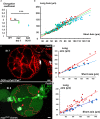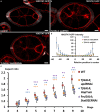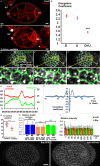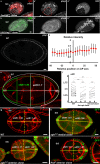Jak-Stat pathway induces Drosophila follicle elongation by a gradient of apical contractility
- PMID: 29420170
- PMCID: PMC5805408
- DOI: 10.7554/eLife.32943
Jak-Stat pathway induces Drosophila follicle elongation by a gradient of apical contractility
Abstract
Tissue elongation and its control by spatiotemporal signals is a major developmental question. Currently, it is thought that Drosophila ovarian follicular epithelium elongation requires the planar polarization of the basal domain cytoskeleton and of the extra-cellular matrix, associated with a dynamic process of rotation around the anteroposterior axis. Here we show, by careful kinetic analysis of fat2 mutants, that neither basal planar polarization nor rotation is required during a first phase of follicle elongation. Conversely, a JAK-STAT signaling gradient from each follicle pole orients early elongation. JAK-STAT controls apical pulsatile contractions, and Myosin II activity inhibition affects both pulses and early elongation. Early elongation is associated with apical constriction at the poles and with oriented cell rearrangements, but without any visible planar cell polarization of the apical domain. Thus, a morphogen gradient can trigger tissue elongation through a control of cell pulsing and without a planar cell polarity requirement.
Keywords: D. melanogaster; developmental biology; dynamics; morphogen; morphogenesis; stem cells.
© 2018, Alégot et al.
Conflict of interest statement
HA, PP, OB, VM No competing interests declared
Figures













Similar articles
-
Glypicans regulate JAK/STAT signaling and distribution of the Unpaired morphogen.Development. 2012 Nov;139(22):4162-71. doi: 10.1242/dev.078055. Development. 2012. PMID: 23093424 Free PMC article.
-
Repression of Wasp by JAK/STAT signalling inhibits medial actomyosin network assembly and apical cell constriction in intercalating epithelial cells.Development. 2009 Dec;136(24):4199-212. doi: 10.1242/dev.040402. Development. 2009. PMID: 19934015
-
Interpretation of the UPD/JAK/STAT morphogen gradient in Drosophila follicle cells.Cell Cycle. 2009 Sep 15;8(18):2917-25. doi: 10.4161/cc.8.18.9547. Epub 2009 Sep 16. Cell Cycle. 2009. PMID: 19729999 Free PMC article.
-
Organogenesis and tumorigenesis: insight from the JAK/STAT pathway in the Drosophila eye.Dev Dyn. 2010 Oct;239(10):2522-33. doi: 10.1002/dvdy.22394. Dev Dyn. 2010. PMID: 20737505 Free PMC article. Review.
-
JAK/STAT pathway dysregulation in tumors: a Drosophila perspective.Semin Cell Dev Biol. 2014 Apr;28:96-103. doi: 10.1016/j.semcdb.2014.03.023. Epub 2014 Mar 28. Semin Cell Dev Biol. 2014. PMID: 24685611 Free PMC article. Review.
Cited by
-
Tissue tension and not interphase cell shape determines cell division orientation in the Drosophila follicular epithelium.EMBO J. 2019 Feb 1;38(3):e100072. doi: 10.15252/embj.2018100072. Epub 2018 Nov 26. EMBO J. 2019. PMID: 30478193 Free PMC article.
-
The dPix-Git complex is essential to coordinate epithelial morphogenesis and regulate myosin during Drosophila egg chamber development.PLoS Genet. 2019 May 22;15(5):e1008083. doi: 10.1371/journal.pgen.1008083. eCollection 2019 May. PLoS Genet. 2019. PMID: 31116733 Free PMC article.
-
Finishing the egg.Genetics. 2024 Jan 3;226(1):iyad183. doi: 10.1093/genetics/iyad183. Genetics. 2024. PMID: 38000906 Free PMC article.
-
Basement membrane patterning by spatial deployment of a secretion-regulating protease.bioRxiv [Preprint]. 2024 Jul 10:2024.07.06.602330. doi: 10.1101/2024.07.06.602330. bioRxiv. 2024. Update in: Proc Natl Acad Sci U S A. 2025 May 20;122(20):e2412161122. doi: 10.1073/pnas.2412161122. PMID: 39026720 Free PMC article. Updated. Preprint.
-
A Gene Expression Screen in Drosophila melanogaster Identifies Novel JAK/STAT and EGFR Targets During Oogenesis.G3 (Bethesda). 2019 Jan 9;9(1):47-60. doi: 10.1534/g3.118.200786. G3 (Bethesda). 2019. PMID: 30385460 Free PMC article.
References
Publication types
MeSH terms
Substances
LinkOut - more resources
Full Text Sources
Other Literature Sources
Molecular Biology Databases

